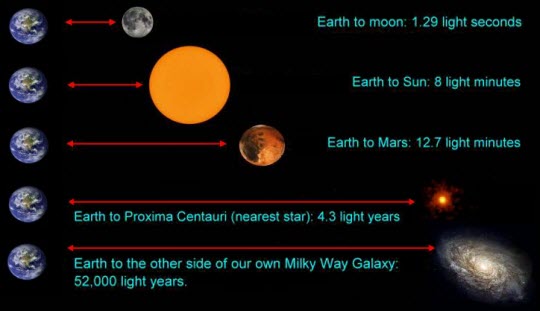Nights are now at their lightest and even the brightest stars are not visible before 10:30pm. The three most conspicuous stars (not planets) in the sky are Arcturus; visible high to the SSW, Vega; high to the NNE and Capella low to the north. Each of these summer luminaries may be regarded as being in our solar neighbourhood, some 36, 27 and 42 light years distant respectively.
The term ‘light year’ is often used to describe a stars distance, but is it a measurement of time, or distance? The answer to this could be ‘yes’ and ‘yes’, for there is a case that it applies to both. Certainly, a light year is used by astronomers as the standard measuring ‘yard stick’ with regard to stellar distances, but this in turn offers up some rather intriguing consequences as we shall see.
 Space is big, no really; it is staggeringly vast, truly beyond human comprehension. Our closest neighbour, the Moon, is just under a quarter of a million miles away. To walk there would take approximately 6 years! Go by car and you could make the journey in approximately 6 months, a plane would reduce this to just under 20 days. The Saturn V rocket used for the Apollo missions made the trip in 3 days.
Space is big, no really; it is staggeringly vast, truly beyond human comprehension. Our closest neighbour, the Moon, is just under a quarter of a million miles away. To walk there would take approximately 6 years! Go by car and you could make the journey in approximately 6 months, a plane would reduce this to just under 20 days. The Saturn V rocket used for the Apollo missions made the trip in 3 days.
Our nearest star; the Sun, is approximately 93 million miles away and even if you could use the Saturn V rocket it would still require over 5 months before you became ‘toast’.
The space probe Voyager 1 was launched 38 years ago and travelling at over 25,000mph and some 20 billion Km from Earth, it is only now at the fringes of our known solar system. Put another way, that’s a ‘generation’ in time and yet we have barely made it out of our own “solar back yard”.
The nearest star system of Alpha Centauri is some 25 million, million miles away (25 trillion). Hitch a ride on Voyager and you would become quite bored after 100 thousand years of travelling. So, once outside the confines of our solar backyard, it becomes quite apparent that measuring space in miles or Km is quite meaningless.
A more convenient method is required and fortunately one exists; the speed of light. Light travels at a finite speed - 186,000 miles (300,000km) per second. In the time taken to read “THIS WORD”, light waves have travelled around Earth 7 times, and will travel almost 6 million million miles in one year. At such a speed the Moon is a mere 1.3 light seconds away, our Sun a handy 8.3 light minutes, and Neptune a manageable 4 hours. Voyager 1 is getting on for 30 hrs away.
Even at this speed it takes just over 4 years for light to reach us from our nearest stellar neighbours in the Alpha Centauri system, to be precise 4.23 light years.. just the nearest star. Hopefully, you have already made the connection, the remoteness of the stars also equates to a time dimension. How FAR light travels from a certain stellar object is also the same as how MANY years it takes to reach us. In effect because of the huge distances involved we view objects as they used to be.

So when the next clear evening presents itself, and the brighter stars emerge, look for sparkling Vega, the brilliant star rising in the northeast. Its steely-blue light started its journey almost 27 years ago, the Soviets were withdrawing from Afghanistan and Ben Johnson was stripped of his 100m sprint Olympic gold medal in Seoul. Nine years earlier Margaret Thatcher became UK prime minister and the Soviets were just invading Afghanistan, when the light from Arcturus started out. Meanwhile the Glam Rock was in its heyday when photons from the binary star system of Capella set off.
Not all of the brighter summer stars are ‘close by’. For instance conspicuous Deneb, in Cygnus, currently climbing into the ENE, is a true cosmic searchlight. The light from the ‘swan’s tail’ is dimmed only by a journey spanning some 1700 light years! Gaze at Deneb and you see a star as it used to be when the Romans occupied Britain – and what did they ever do for us?! So if you want to become a time lord like Dr Who, then just fix your eyes on the heavens and trip the light fantastic.
- Log in to post comments
